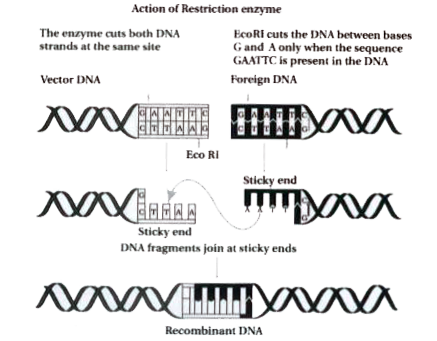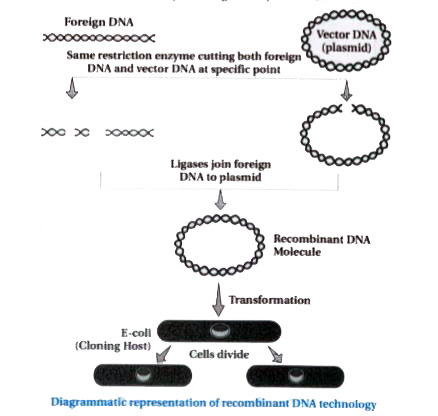Give types and functions of Nuclease Enzyme.
Text Solution
Restriction enzymes belong to a larger class of enzymes called nucleases.
(i) Exonuclease Enzymes : They remove nucleotides from the ends of the DNA.
(ii) Endonuclease : Endonucleases make cuts at specific positions within the DNA.

Each restriction endonuclease functions by inspecting the length of a DNA sequence. Once it finds the specific recognition sequence it will bind to the DNA.
And cut each of the two strands of the double helix at specific points in their sugar phosphate backbones.
Each restriction endonuclease recognises a specific palindromic nucleotide sequence in the DNA.
The palindrome in DNA is a sequence of base pairs that reads same on the two strands when orientation of reading is kept the same.
E.g. the following sequences reads the same on the two strands in 5.→3. direction. This is also true if read in the 3.→5. direction. 5.−GAATTC−3.
3.−CTTAAG−5.
When restriction endonuclease work on Polyandrome then it cuts both sequences of DNA molecule.
Some enzymes cut two strands symmetrically and make blunt ends while other enzymes cut the strands asymmetrically and make sticky ends.
In recombinant - DNA technology such enzymes are used which cut DNA and make sticky ends.
While plasmids and desired/Foreign DNA, both are cut by same enzyme, the resultant DNA fragments have the same kind of sticky ends.
Such cut fragments of DNA can be joined together by use of DNA ligase enzyme.

Unless one cuts the vector and source DNA with the same restriction enzyme, the recombinant vector molecule cannot be created.
|
Updated on:21/07/2023
Related Playlists
- BOOK - KUMAR PRAKASHANCHAPTER - BIOTECHNOLOGY : PRINCIPLES AND PROCESSESEXERCISE - SECTION - B (DIFFERENCE/SCIENTIFIC REASONS)5videos
BIOTECHNOLOGY : PRINCIPLES AND PROCESSES
- BOOK - KUMAR PRAKASHANCHAPTER - BIOTECHNOLOGY : PRINCIPLES AND PROCESSESEXERCISE - SECTION - C (OBJECTIVE QUESTIONS - ANSWERS)6videos
BIOTECHNOLOGY : PRINCIPLES AND PROCESSES
- BOOK - KUMAR PRAKASHANCHAPTER - BIODIVERSITY AND CONSERVATIONEXERCISE - SECTION - F (MCQs A SKED IN COMPETITIVE EXAM)70videos
BIODIVERSITY AND CONSERVATION
- BOOK - KUMAR PRAKASHANCHAPTER - BIOTECHNOLOGY AND ITS APPLICATIONSEXERCISE - Section - F (Multiple Choice Questions (MCQs ASKED IN COMPETITIVE EXAM))90videos
BIOTECHNOLOGY AND ITS APPLICATIONS
Similar Questions
Function of Nucleases :
View SolutionFunction of Nucleases :
View SolutionGive the names and functions of enzymes involved in lactose metabolism in E. Coli:
View SolutionThe function of nucleases is to:
View SolutionThe function of an enzyme is to
View SolutionThe function of an enzyme is to
View SolutionThe function of an enzyme is to
View SolutionGive the source and function of Streptokinase enzyme.
View SolutionWhat is the function of enzyme nuclease in the pancreatic juice?
View SolutionWhat is the function of enzyme nuclease in the pancreatic juice?
View Solution

